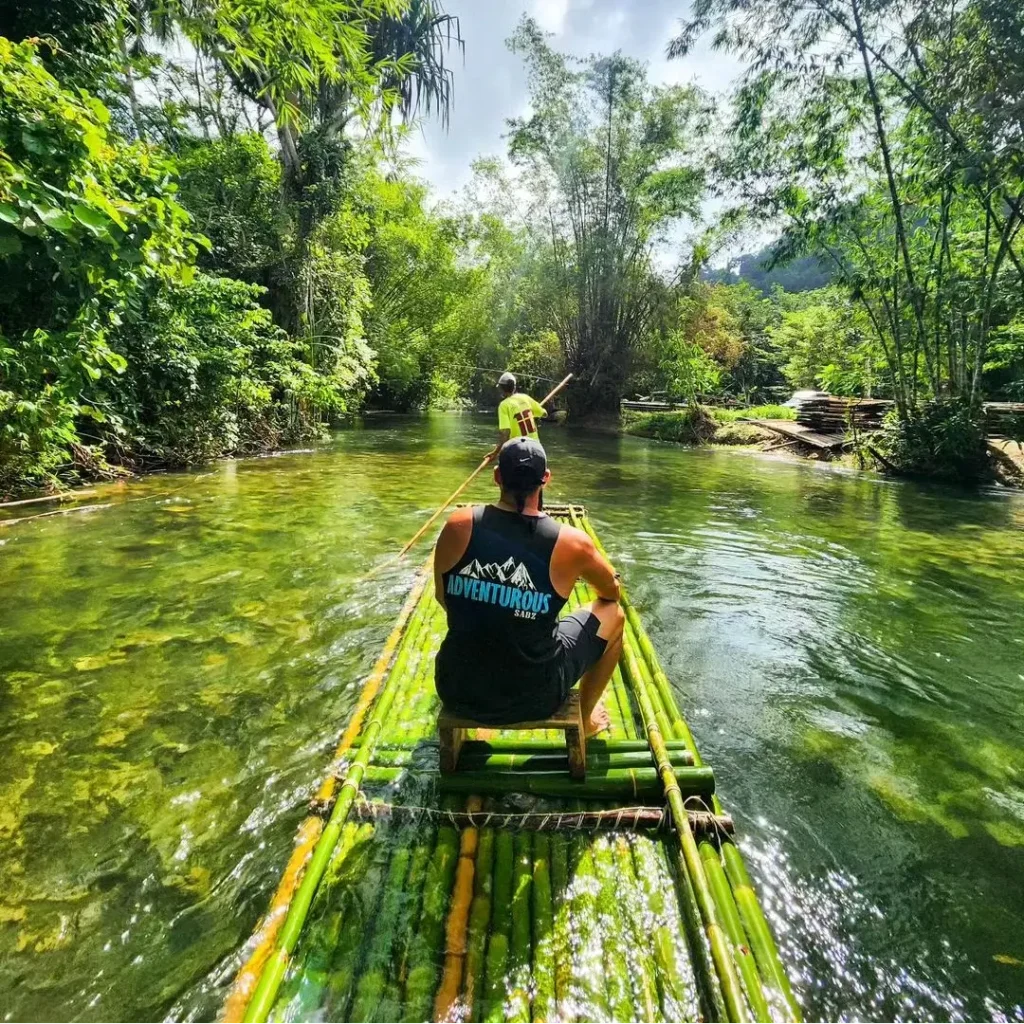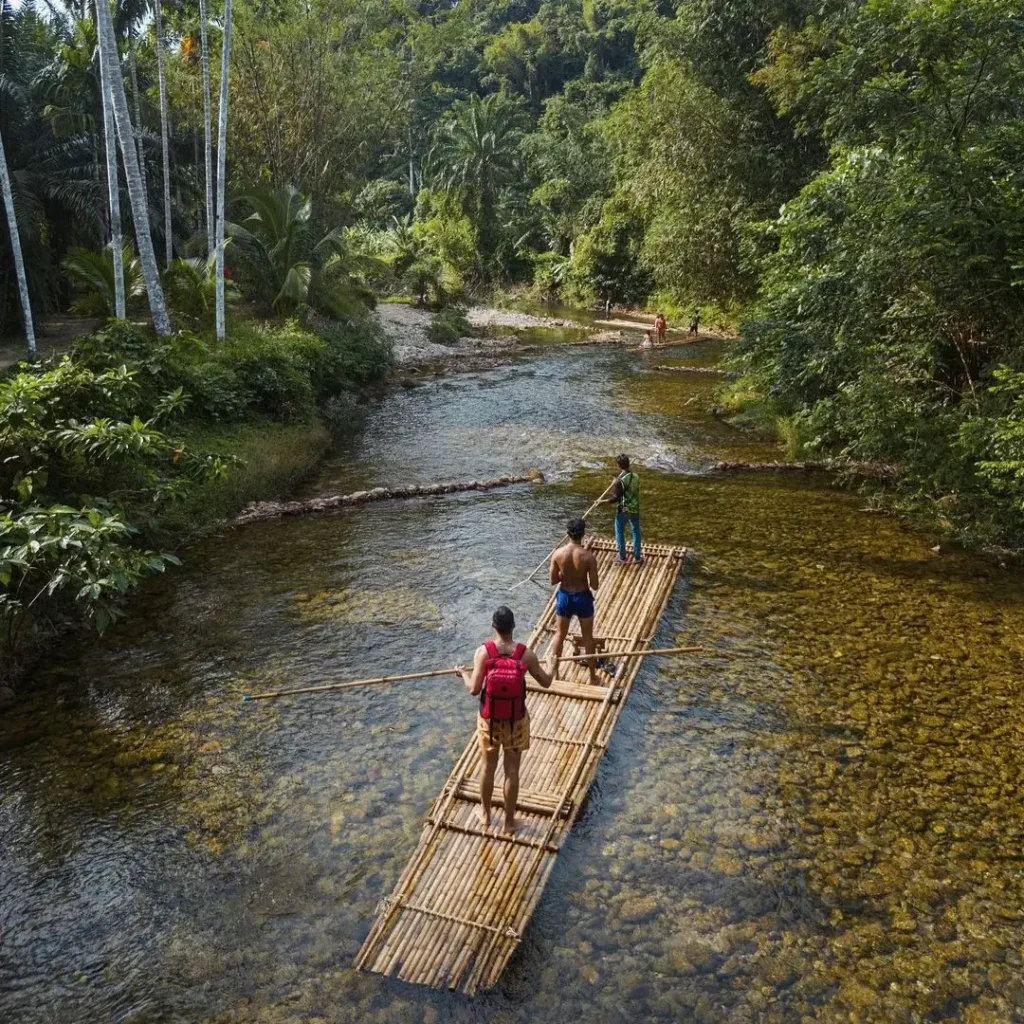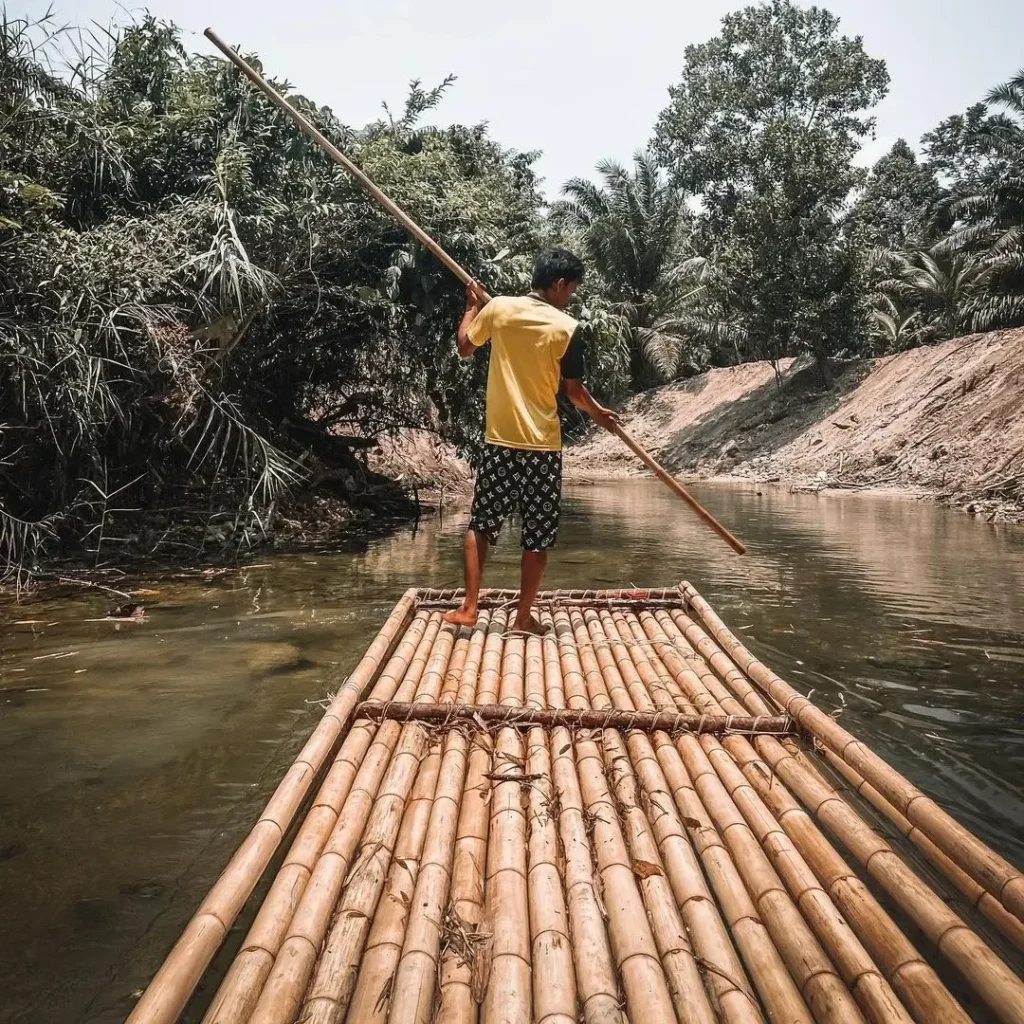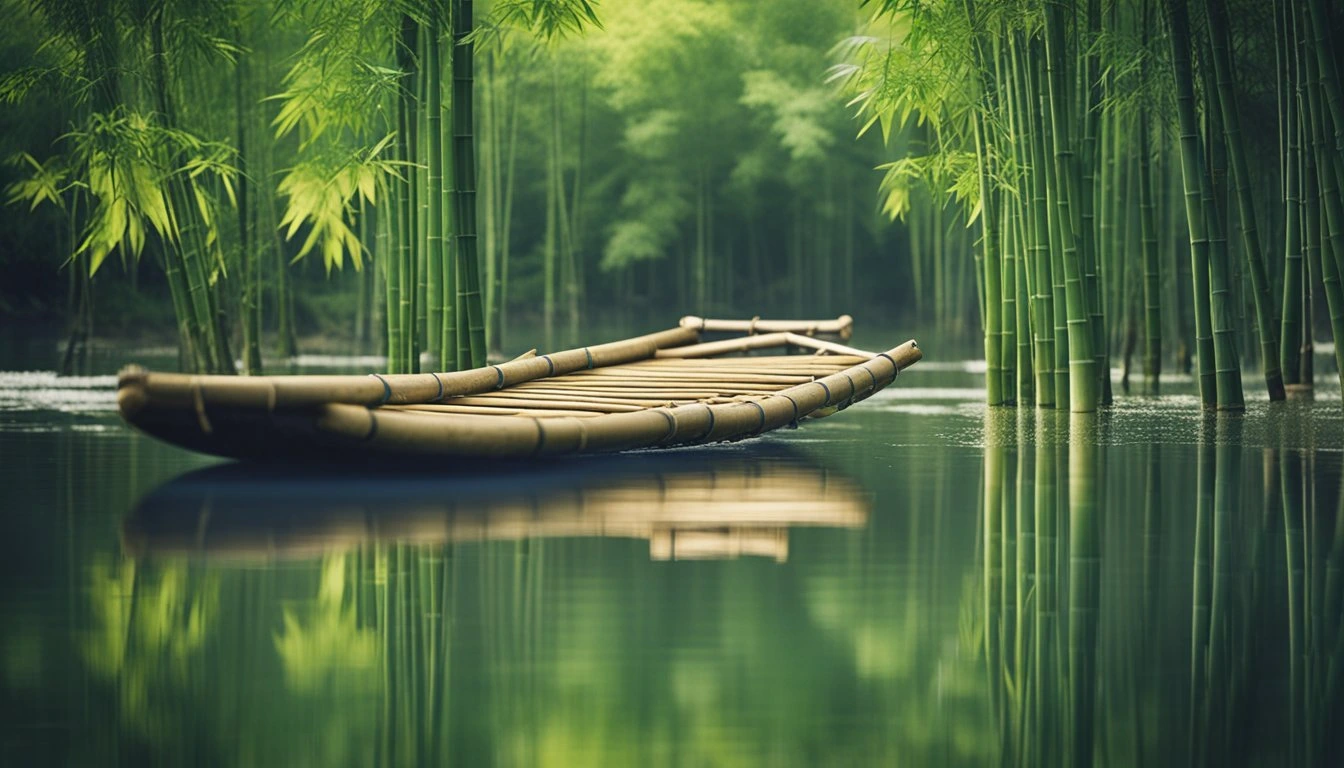Imagine gliding along a tranquil river on a bamboo raft, surrounded by lush greenery and the sounds of nature. This is the unique and relaxing experience of bamboo rafting, an activity that has been enjoyed for centuries in various parts of the world. In recent years, it has gained popularity as a fun and eco-friendly way to explore some of the most scenic and untouched landscapes.
We’re sure you’ve had your fair share of adventures, but bamboo rafting offers a different kind of thrill. Picture yourself floating down a meandering river, with the sun on your face and the gentle sway of the raft beneath your feet. The simplicity of the raft’s design, made from tied bamboo stalks, takes us back to our roots and reminds us of the beauty in nature’s offerings.
If you’ve been seeking a unique outdoor adventure that’s friendly to the environment, look no further than bamboo rafting. It’s the perfect blend of relaxation and exploration, allowing you to connect with nature in a way that few other activities can. So grab your friends and family, and embark on a bamboo rafting journey that’s sure to create memories that’ll last a lifetime.
____________________________________________________________________________
You want to know what rafting is? Then check out the following article.
____________________________________________________________________________
History of Bamboo Rafting
Bamboo rafting is a fascinating practice with roots dating back thousands of years. This humble, yet ingenious mode of transportation has evolved from being a crucial means of trade to becoming a popular recreational activity in modern times.
Originating around 3,000 BC, bamboo rafts were primarily used for transportation and commercial activities. Composed of bamboo pieces lashed together with durable tree vines or rope, they provided a reliable and efficient method for moving goods across waterways. In places like Jamaica, bamboo rafting was historically utilized to transport goods like sugar which were essential in their colonial activities.
As time went by, the use of these versatile watercraft expanded in numerous ways. In East Asia, for example, bamboo rafts were constructed to resemble traditional mat-shaped crafts used by the Amis people. These rafts could measure up to 9 meters in length and 1 meter in width, perfect for navigating rivers and coastal regions.
Nowadays, we see bamboo rafting becoming a popular tourist attraction, offering unique experiences that blend both adventure and history. Travelers who embark on a bamboo rafting journey in Jamaica can enjoy a serene venture upriver, while being immersed in a rich cultural background.
Moreover, thrill-seekers can also try their hand at bamboo rafting in Chiang Mai, traveling aboard a 25-foot-long raft made of bamboo held together by ropes. This exhilarating adventure can be easily booked through organized tours or arranged independently for a more personal experience.
So, as we set sail on bamboo rafts, we not only float on the waters, but also float through time, exploring the amazing history of this ingeniously crafted vessel.
Process of Building a Bamboo Raft
Bamboo rafting is an eco-friendly way to explore the great outdoors and get closer to nature. Building a raft from bamboo is a rewarding process, and it’s not as difficult as you might think. In this section, we’ll guide you through the materials needed and the steps to construct your very own bamboo raft.

Materials Needed
To begin your bamboo rafting adventure, gather the following materials:
- Mature, dried bamboo poles: Using green bamboo will make your raft too heavy and cause it to sink. Aim for at least 8-10 poles for a raft that can accommodate up to 4 passengers. The lighter the color of the skin, the stronger the bamboo.
- Cutting tools: You’ll need these to measure and cut the bamboo poles to your desired length.
- Lashing rope: A strong, weather-resistant rope to bind your bamboo poles together securely.
Make sure that all the materials are readily available before starting the construction process
Steps to Construct
- Measure and cut the bamboo poles: Determine the size and shape of your raft and cut the bamboo poles accordingly. Ensure that each pole is of equal length for a balanced raft.
- Lay out the bamboo poles: Arrange the poles in your desired raft shape, such as a rectangular or triangular pattern.
- Secure the poles: Once your poles are laid out, use the lashing rope to bind the bamboo poles together securely. Lash the poles at each contact point to ensure stability.
- Check for symmetry: Before setting out on your bamboo rafting trip, make sure that your raft is symmetric, with no protruding poles or items that could cause instability.
- Add any desired modifications: You can add a small shelter, seating, or a platform for fishing if desired. Just make sure not to weigh your raft down excessively.
Now, you have your very own bamboo raft, ready for a day of adventure and exploration in nature. Enjoy the ride and remember always to prioritize safety while bamboo rafting!
Popular Bamboo Rafting Locations
Bamboo rafting is an adventurous and eco-friendly way to explore the world’s breathtaking waterways. We’re excited to share with you some of the popular bamboo rafting locations across Africa, America, and Asia. So let’s dive in!

Africa
In Africa, bamboo rafting is most popular in the majestic rivers of Uganda. The Nile river, specifically, offers an unforgettable rafting experience with its calm stretches and thrilling rapids. Uganda’s lush and diverse ecosystems provide a stunning backdrop for your bamboo rafting adventure.
America
When it comes to bamboo rafting in America, Jamaica takes the spotlight with its beautiful rivers and unique rafting experiences. The Martha Brae River and the Rio Grande River both offer tranquil bamboo rafting rides on their 30-feet long bamboo rafts, suitable for couples or small groups seeking a relaxing getaway. Bond with your loved ones while experiencing the awe-inspiring scenery of Jamaica’s lush greenery and vibrant culture.
Asia
Asia offers some fantastic opportunities for bamboo rafting. China, for example, is home to the picturesque Li River, where you can enjoy a leisurely ride on a bamboo raft while marveling at the astonishing limestone karsts that surround the river. In Indonesia, the Green Canyon in West Java is a hidden gem for bamboo rafting enthusiasts, where one can drift calmly along the jade-colored water, accompanied by the sights and sounds of the surrounding rainforest.

Together, we hope to have inspired you with these remarkable bamboo rafting locations across Africa, America, and Asia. Each destination offers a unique and unforgettable experience, so which one will you choose for your next adventure?
Benefits of Bamboo Rafting
Bamboo rafting is an excellent way to explore nature or participate in a unique recreational activity. In this section, we’ll discuss the benefits of bamboo rafting in terms of recreational, educational, and environmental impact and sustainability.
Recreational
Bamboo rafting offers a unique and enjoyable experience for people seeking a different kind of adventure. Floating down a serene river on a handmade bamboo raft allows us to enjoy the beauty of the surroundings and offers a tranquil escape from everyday life. There are even thrilling experiences like riding the rapids for those seeking more excitement.
Educational
While bamboo rafting, we can learn about the river’s flora and fauna, and gain insights into local ecosystems from experienced guides. Rafting also offers an opportunity to learn about the history and culture of the areas we visit. For example, bamboo rafting in Jamaica provides insights into the region’s past.
Environmental Impact and Sustainability
Crafting rafts from bamboo is an eco-friendly practice as it uses one of Earth’s most sustainable resources. Bamboo grows quickly and can be harvested without causing damage to the plant’s root system. Moreover, these rafts have a low environmental impact due to their simple construction, which makes them biodegradable.
In conclusion, bamboo rafting offers numerous benefits that make it an enjoyable, educational, and sustainable activity. Whether we partake in it for leisure or adventure, the experience of bamboo rafting is something that will stay with us forever.

Our Opinion about Bamboo Rafting
We absolutely love bamboo rafting! The moment we experienced the tranquility of floating down a serene river, surrounded by lush nature, we were hooked. There’s something uniquely calming about traveling on a handmade raft crafted from one of the earth’s most sustainable resources.
This simple yet effective mode of transportation has been around for thousands of years and has evolved into an eco-friendly way to explore the waters. The design of bamboo rafts is not only practical but also quite charming with the way the long pieces of bamboo are tied together.
What makes bamboo rafting enjoyable is its accessibility to people of all ages and skill levels. The slow-moving rafts make for one of the most relaxed travel experiences in nature. Plus, it’s a great bonding activity with friends or family, as everyone gets to work together navigating the raft along the river.
During our bamboo rafting adventures, we loved the moments when we spotted wildlife and marveled at the picturesque surroundings. We found that this method of exploration allows us to truly absorb the beauty of our environment. Moreover, it offers a unique perspective on the natural world that we often miss in our fast-paced daily lives.
In conclusion, we highly recommend giving bamboo rafting a try, as it’s a genuinely enjoyable and sustainable way to explore rivers and nature.
What should I wear for bamboo rafting?
Wear comfortable clothes and footwear that can get wet. Bring a change of clothes and a towel.
Is bamboo rafting safe?
Yes, it is generally safe as long as you follow the instructions of your guide.
What is the best time of the year for bamboo rafting?
It depends on the location, but generally the dry season is the best time as the water levels are lower and the weather is more predictable.
Ready to embark on your bamboo rafting adventure? Let us know in the comments!

